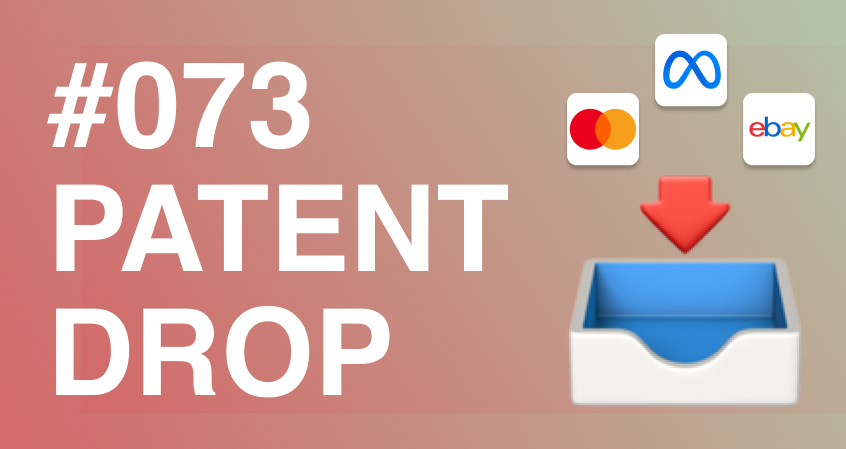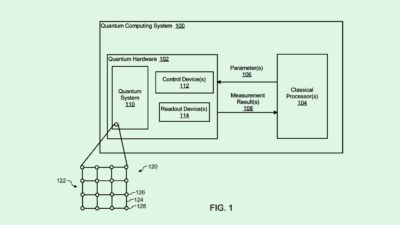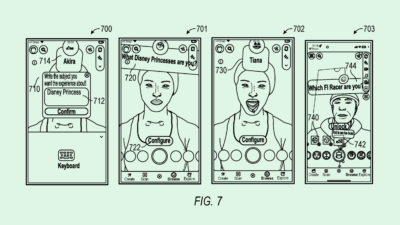Sign up to uncover the latest in emerging technology.
Plus: eBay is AI digital advertising; Mastercard is fighting phishing with phishing
Happy Thursday and welcome to Patent Drop!
Today, we’re taking a look at Meta’s plans to make the metaverse greener; eBay’s AI-powered digital advertising; and Mastercard’s goal to fight phishing with phishing.
Let’s get into it.
#1. Meta’s greener computing
Looks like Meta’s “year of efficiency” might include energy efficiency, too.
The company filed a patent application for tech to make sequential access to SRAM, or Static Random Access Memory, more energy efficient. This tech works by sharing a “row address strobe” phase, or signal sent by a device to access data for a task, between multiple pieces of data that are being accessed, “so that the energy used to open the row is shared across the sequential accesses,” Meta said in its filing.
Yeah, it’s a lot, so let’s think of it like this: Two people are standing at your front door. Rather than taking the energy to open and close the door twice to let each one in, you open the door once and allow both in at the same time. That saves a lot of energy by, essentially, multitasking.
But as complex as this tech sounds, the important part is its simpler outcome: This tech provides energy-efficient processing for computing that traditionally consumes excess power.
“Conventional sequential SRAM access, e.g., using a traditional memory controller, is less energy efficient because energy is wasted in conditioning the rows and columns of the memory array with each read or write operation, regardless of the access pattern,” Meta said in its filing.

So why does this matter IRL? Meta developing tech like this could be crucial for it to fulfill its metaverse ambitions without burning up the earth. The company noted in its application that this kind of tech could be implemented in artificial reality systems like AR, VR and mixed reality, all of which require computing that generally squanders tons of power to provide high-quality content.
As tech like this continues to rise, analysts and researchers have addressed their concerns about its environmental impact. In an article last year, the World Economic Forum and nonprofit Green Matters said that the onset of metaverse technologies could increase greenhouse gas emissions and e-waste. And the tech used to build and render the metaverse, like AI models and cloud computing, come with their own steep energy costs, UNESCO researchers wrote in a recent article.
Green computing, or employing energy efficient systems, could limit the damage. And Meta’s not the only company working on this: IBM is working with Samsung on creating more energy-efficient chips, and Nvidia is offering greener GPUs to train AI and machine learning models more efficiently.
With CEO Mark Zuckerberg committing to prioritizing AI and metaverse tech, even amid what he has called Meta’s “year of efficiency,” finding ways to continue development while mitigating the pain of rising electricity charges definitely wouldn’t hurt the company’s pocketbook.
If Meta keeps pouring money into the metaverse, at the very least this tech will help it save a few bucks on its power bill.
#2. EBay’s AI ad machine
EBay is adding a sprinkle of AI to its digital ad tech to track where you almost bought something.
The company seeks to patent tech that uses machine learning to generate “personalized banner ads.” Essentially, it takes user data “pertaining to user behavior in relation to an image of a product,” this system uses machine learning to generate a banner ad for that product.
For instance, say you’re searching eBay for vintage watches, and you find one that you really like. You click it and look at the product information but eventually, you scroll away. Using this tech, eBay will then create a specialized banner ad for that product or similar ones to draw you back in.
In addition to looking out for products you interact with, eBay’s tech will create banner ads that “aesthetically appeal to particular users or to groups of users based on continuous machine learning of what types of online banners are selected by various users.” Meaning, if you or users in your demographic react to banner ads of certain colors or design elements, this system will pick up on that to deliver “highly-customized” ads.
“A stock image of a product may not accurately represent the product in which the user is interested, and therefore may not capture the user’s attention,” eBay said in its application. “In addition, the banner images are often pre-defined and generated in advance, and by the time the online banners are shown to users they are not relevant to the users anymore.”

EBay was an early adopter of programmatic advertising, a.k.a. the automation of media buying, so the company making the move to implement AI into its digital ad toolkit seems like a logical next step, said Dan Ratner, founder and CEO of Australian branding agency uberbrand. With this patent, eBay is looking to take the guesswork out of digital advertising all together.
“There’s the classic statement that 50% of advertising works, you just don’t know which 50%,” Ratner said. “This is (eBay) trying to improve their odds.”
While this tech has the potential to make advertisers’ lives way easier, Ratner finds it somewhat “daunting” for its potential to take the human element out of creativity and communication.
“There’s good in it because it’s creating efficiencies around how you target and implement your marketing, but it’s no longer people talking to people,” he said. “It’s a machine talking to people.”
But an AI is only as good as the material it’s trained on. EBay, like all other companies trying to implement AI in some way, shape, or form, has to be careful with how it trains its machine learning algorithms that make its banner ads, especially if they’re basing the designs on demographic information. Otherwise, the company could end up serving up biased advertisements that turn users off from eBay as a whole.
#3. Mastercard’s phishing trip
Mastercard is fighting fire with fire… or in this case, phishing with phishing.
The company wants to patent tech that automatically generates phishing emails to prevent phishing emails. Here’s how it works: A generative neural network creates several phishing emails ranging in complexity. Then, the “reinforcement learning system” sends one of them out to the user, basing the email’s level of complexity on their past user behavior. Based on the user’s reaction – whether or not they could identify the email as phishing – the system will adjust accordingly for the next time it sends emails.
For example, if a user is able to identify an email that has obvious signs of phishing – misspelled words, asking the user for an unusual request, etc. – the next email sent out might be more realistic, and therefore more challenging to identify. Mastercard’s theory is that by educating the user of these phishing attacks with phishing emails that end up being harmless, users will be able to better identify and avoid those attacks in the future. Mastercard noted that this could help train an organization’s employees in fighting phishing attacks.
“One of the best forms of inhibiting such phishing attacks is to be able to educate users to identify a phishing email and ignore or avoid it,” Mastercard said in its filing. “However, a challenge exists in providing such user education about phishing attacks without exposing them to real phishing attacks.”

When you think of generative AI, you’re most likely imagining DALL-E conjuring images of cats playing basketball on a whim, or ChatGPT conversations that manage to turn a recipe for muffins into a Shakespeare poem. But generative AI has its uses far outside the realm of outlandish art, and Mastercard’s patent application is just an example.
This kind of AI has potential uses in pharmaceuticals, industrial design, software engineering, and more. And with $1.7 billion VC dollars invested in generative AI to date according to consulting firm Gartner, only more innovations are on the way.
Outside of generative AI, we’re already seeing AI being put to use in fintech cybersecurity, for example, with PayPal’s recent patent application for fraud detection using machine learning, aiming to catch incidents payments fraud and account takeovers before they happen.
Mastercard’s filing adds to the growing pile of examples that generative AI, and AI generally, are slowly creeping into every sector from arts to medicine to finance.
Extra Drops
We’re not finished just yet.
Ford wants to make a robot arm. The company seeks to patent a “robotic gripper apparatus” to help assemble its vehicles. And yes, it looks exactly how you’d think.
Microsoft wants to set the record straight. The company is looking to patent tech for “concurrent edit detection,” which keeps track of “potential conflicts that may be caused by edits made by other collaborators” in a document – kind of like an upleveled Google Doc.
Spotify wants to become your local dive bar’s DJ. The company filed a patent application for tech that uses an algorithm for “creating song mashups” automatically of any two songs, aiming to cater to every users’ specific taste.
What else is new?
TikTok is in hot water with government officials. The U.K. has banned the app on government devices, and U.S. officials have reportedly threatened to ban it if the company’s Chinese owners don’t divest.
GPT-4 is here, but AI experts are worried that OpenAI isn’t being as open as it should by not offering information on the data used to train the new program.
Stripe announced a Series I funding round, raising $6.5 billion at a valuation of $50 billion, down from it’s previous $95 billion valuation from March 2021.
Stocks: Shaky. Recession Fears: Mounting. No sweat for WebStreet investors 一 they’re sidestepping the turmoil and raking in profits. WebStreet pairs accredited investors with handpicked portfolio managers that specialize in high-growth online businesses in digital content, affiliate marketing, and Amazon FBA. They handle all the finer points while you pile up quarterly distributions from these recession-resistant alternative assets 一 Round 1 Funds delivered 15% cash yields in 2022. Gain exposure to high-upside online businesses with WebStreet.*
*Partner
Have any comments, tips or suggestions? Drop us a line! Email at admin@patentdrop.xyz or shoot us a DM on Twitter @patentdrop.












